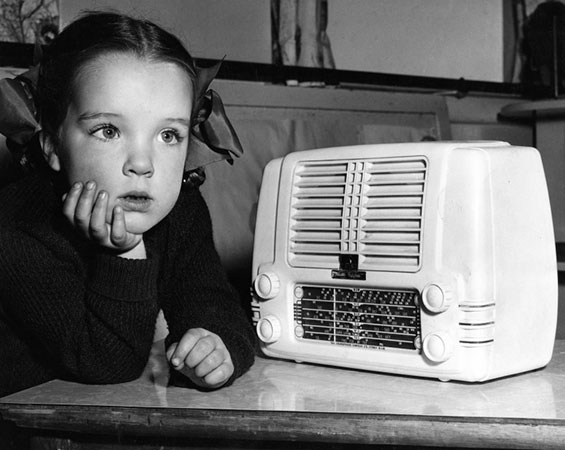How they make the radio

This is the desired response to good radio. Photo: Australian Broadcasting Company, Creative Commons, some rights reserved
As you scan across the dial on your radio, there’s no mistaking the sound of public radio. You can almost always tell within a few seconds of listening where you are along the public/commercial spectrum.
And that quality of sound, that approach to storytelling and reporting and entertainment does not come about by accident. There are mavens and mentors of that sound, some of whom were around when the whole approach was being invented, some of whom are newer to the trade. And there are organizations that foster the approach, and train new generations of radio producers.
One of those mavens is Jay Allison, who has been around public radio since its early years. His Transom organization in Woods Hole, MA has been teaching the art of radio storytelling to new voices for more than a decade. Among them were two of NCPR’s own younger reporters, Sarah Harris and Zach Hirsch.
In order to understand the voodoo that they do, it helps to hear it from the source. A recent project from Transom, “This is Radio,” does just that. It’s a series of videos in which some of the most interesting and innovative producers in the medium talk about how they do their work.
I agree with Vimeo’s “staff pick”–the video of 99% Invisible producer Roman Mars. Roman will be familiar to many of you as the curator of the Public Radio Remix stream, heard in St. Lawrence County at 88.7 fm. It opens with him talking about the moment his own show came together in his head.
“I think that the stories that work for me are the ones that are about the things you kind of notice, but don’t really notice… They have resonance because you recognize, like, ‘Oh, yeah, I have seen that everywhere, but I just never really put my finger on it.’ It was the name–99% Invisible–was the moment that I knew I had the show… I can use that–the idea of that mystery. I can use that to tell design stories; I can use that to tell any story.”
In their video, Nikki Silva and Davia Nelson, better known to public radio listeners as “The Kitchen Sisters,” share their passion about storytelling.
“We are definitely story collectors; I think collecting is in in our blood. You know, it’s exciting, it’s like these little discoveries, it’s like prospectors who are mining for gold. You know, having something that is just shimmering, and so hot and dynamic and compelling that you just have to follow it. Your mind starts immediately hearing all the things that might go with it: the music, the ambients, the field recordings, the photographs, the other people you might talk to. We say our microphone is a divining rod.”
The thing that comes through most clearly in all these videos is that public radio people love their work. They are people on a mission–a mission to feed your ears, and your mind, and most importantly, your heart. But, Roman Mars warns, you shouldn’t let the mission get in the way of the story. He says:
“We’re often trained–especially in public media–when you’re trying to tell people the importance of the story, that mission infiltrates the way we describe things. And unfortunately, that mission is boring. ‘Mission-speak’ is super boring. I want to hear why you’re there, and why you’re there is usually something so simple.”
So I’ll keep it simple and get off the mission. Just this–if you are a serious listener to public radio, you’ll want to give the voices in these videos a serious listen.
Tags: listeningpost





.jpg)


There is a signature to the sound. The lack of blaring and volume bump whenever a commercial comes on. Todd just announced “This is North Country Public Radio.” One of my radio peeves is failure to declare the physical location of the station. A fellow from New Hampshire remarked to me yesterday, “they call this area the north country and where I live we call it the north country.” I catch radio stations all over when I travel which is frequent. “This is the Bridge” ” This is Froggy” “This is K-Love” Hey- it is nowhere- it is a network not a location.
Several years ago I investigated a fatality in the woods due to a wind thrown tree due to a sudden gust of a windstorm. I asked the local radio station about their emergency broadcast announcement. They were broadcasting their syndicated programming rather than local programming. They were getting ready to cut into the broadcast when the wind took out power to their antenna and the battery at the tower was dead and didn’t start the generator. Can’t exactly blame programming originating states away but that battery was part of the “network” and it was not maintained at one location.